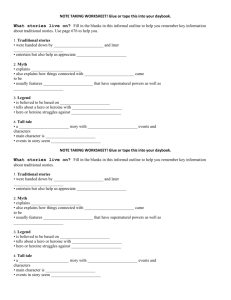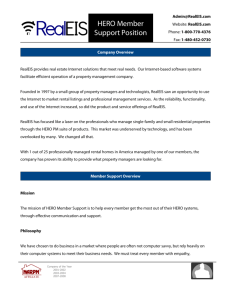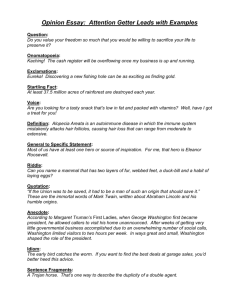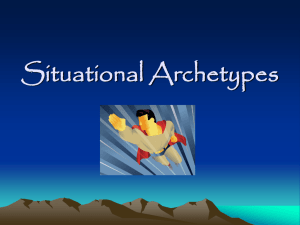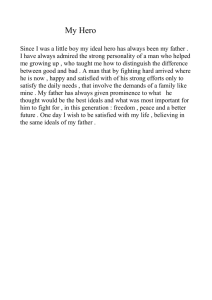Archetype
advertisement
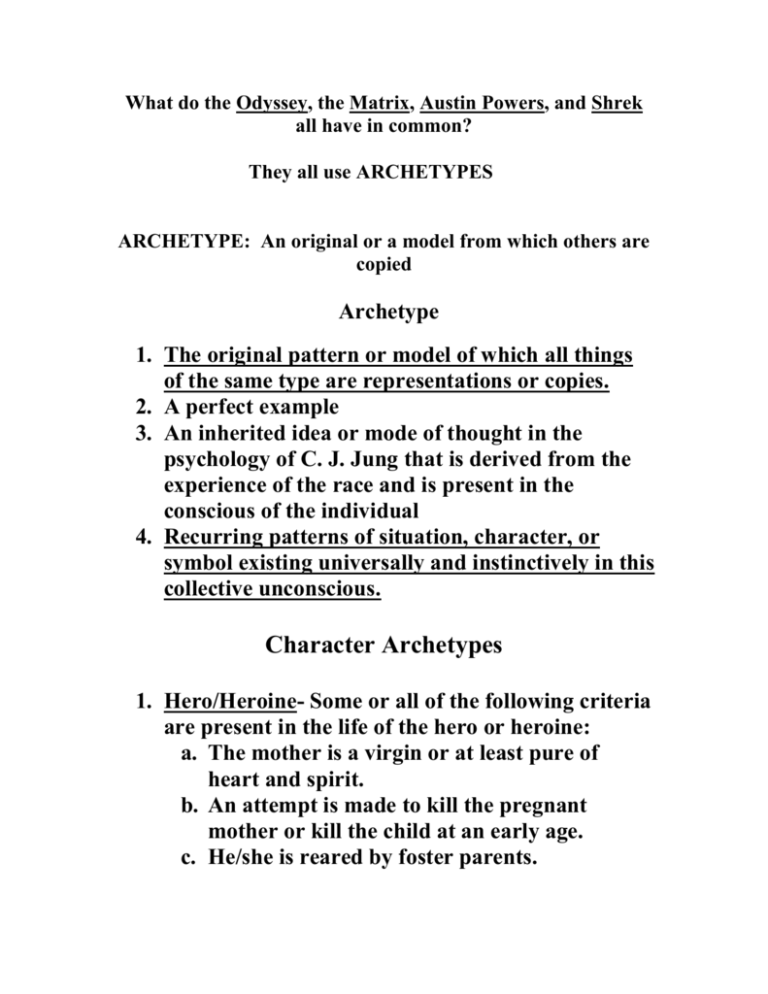
What do the Odyssey, the Matrix, Austin Powers, and Shrek all have in common? They all use ARCHETYPES ARCHETYPE: An original or a model from which others are copied Archetype 1. The original pattern or model of which all things of the same type are representations or copies. 2. A perfect example 3. An inherited idea or mode of thought in the psychology of C. J. Jung that is derived from the experience of the race and is present in the conscious of the individual 4. Recurring patterns of situation, character, or symbol existing universally and instinctively in this collective unconscious. Character Archetypes 1. Hero/Heroine- Some or all of the following criteria are present in the life of the hero or heroine: a. The mother is a virgin or at least pure of heart and spirit. b. An attempt is made to kill the pregnant mother or kill the child at an early age. c. He/she is reared by foster parents. 2. 3. 4. 5. 6. d. (Male) after proving himself (usually defeating a wild beast) marries princess, becomes king, knight or warrior of the realm or village. (Female) possesses unusual skills (often supernatural gifts) and takes on a special role in the kingdom or positions usually occupied by men in that society (spiritual leader, warrior, judge, etc.) Young one from provinces- This hero/heroine is spirited away and raised by strangers. Later returns to his/her home as a stranger with new solutions to kingdom’s problems. The initiates- The hero/heroine, who prior to their quest, must endure some training or ceremony. Initiates are usually innocent and wear white. Mentor-pupil relationship- Mentors serve as teachers or counselors to initiates. The mentor acts as a role model for the protagonist, and can function as father and mother figures to the initiate as well. The mentor teaches by example the skills necessary to survive the quest/task/journey. Parent-child conflict- Tension often results from separation during childhood, from an external source when the individuals meet as adults, or where the mentor often has a higher place in the affections of the hero/heroine than the natural parent. Hunting group of companions- This is a band of loyal companions willing to face any number of perils in order to be together or achieve a common goal. 7. Loyal retainers- Often called sidekicks, these individuals are somewhat like servants who are heroic themselves. Their duty is to protect the hero/heroine and reflect his/her nobility. 8. Friendly beast- These creatures aid or serve the hero/heroine and symbolize how nature is on the side of the hero/heroin. 9. The devil figure- This character is evil incarnate who offers worldly goods, fame or knowledge to the protagonist in exchange for possession of the soul. 10.Devil figure with ultimately good heart- The devil figure who is saved by the nobility or love of the hero. 11.The scapegoat- Human or animal whose death in a public ceremony cleans the sin or evil that has visited upon a community. The death of the scapegoat often makes him/her more powerful than in life. 12.The outcast- A figure who is banished from a social group for some crime (real or imagined) against society. The outcast usually wanders from place to place. 13.Creature of nightmare- A monster summoned from the darkest part of the human psyche to threaten the lives of the hero/heroine. Often is a perversion of human body. 14.The woman figure- Archetypically, male characters generally play one role at a time: the warrior, the holy man, the villain, etc. Women play very special roles in society, or they can play more than one archetype role at a time. The following are a list of the most common female archetypes: a. Earth mother- Symbolic of spiritual and emotional nourishment, she is often depicted in earth colors. She is usually depicted as having large breasts and hips representing childbearing capability. b. The temptress- Sensuous in beauty, this woman brings about the downfall of the hero by tempting him to turn away from his goal. c. The platonic ideal- This is an inspiring woman for whom the protagonist has an intellectual rather than physical attraction. d. The unfaithful wife- A married woman who finds her husband dull or unattractive and seeks a more virile or interesting man. Archetypically, the woman is the center of the family and is responsible for keeping it together. While the role of the father/husband (as provider and protector) can be easily replaced, the absence of the wife/mother (as nurturer and teacher) throws a family into a different kind of chaos than the loss of the male. e. The damsel in distress- This vulnerable woman must be rescued by the hero. She is often a trap by the devil figure or the temptress to ensnare the unsuspecting hero. 15.The star-crossed lovers- This is a love affair fated to end tragically because it receives the disapproval of the society, friends, and/or family. Other times, it is a situation that separates the lovers, such as war, their respective positions in society, where they live, or untimely death. Situational Archetypes 1. Quest- The search for someone or some talisman (object) which, when found or brought back, will restore fertility to a wasted land. 2. Task- To save the kingdom, to win the fair lady, or to prove one’s rightful position, the hero must perform some nearly superhuman deed. This also restores fertility to a wasted land. 3. The Initiation- Usually takes the form of an initiation into adult life – RITE of passage. 4. The Journey- A hero/heroine goes in search of truth or information necessary to restore fertility to the kingdom; usually he/she descends into a real or psychological hell to discover blackest truths concerning his/her faults. a. Journey Variation- A group finds themselves together on a voyage or in an isolated situation; each member of the group will represent a level of society. As a microcosm of society, the group will descend into a real or psychological hell to discover the blackest truths concerning a society or a culture. 5. The Fall- A descent from a high to low state of being which involves a defilement or loss of innocence; often characters are expelled from a kind of paradise as a penalty. 6. Death and Rebirth- A common archetype that draws parallels between the cycle of nature and cycle of life. Morning spring equals birth; evening or winter equals death, etc. 7. Nature vs. Mechanistic World- That which is natural or part of the natural order is good. Technology, which separates people from nature or the natural order, is bad. 8. Battle between good and evil- A battle between two primal forces. The future or the very existence of the kingdom is often at stake. Good triumphs over evil despite great odds, but often a terrible sacrifice by the hero/heroin or by the kingdom as a whole must be made to insure victory. 9. Unhealable Wound- This wound is either real or psychological and cannot be healed fully. This wound often indicates a loss of innocence. The unhealable wound often aches, especially in the presence of what caused the wound, and drives the sufferer to desperate measures. 10.The Ritual- Actual ceremonies that mark the rite of passage into another state or level of society. This rite is a signpost for a character’s role in society (a princess becomes a queen, a squire becomes a knight, a seminary student becomes a priest, etc.) 11.The Magic Weapon- The weapon symbolizes the extraordinary quality of the hero or heroine because no one else can use or wield the weapon. It is given by a mentor figure. Symbolic Archetypes 1. Light vs. Darkness- Light suggests hope, renewal, or intellectual illumination; darkness implies the unknown ignorance, or despair. 2. Water vs. Desert- Water is a symbol of birth, rebirth, or cleansing. A desert is seen as the opposite, or a place of exile. Often the desert is represented by an absence of the expected: lack of wind or waves on the ocean, lack of rain when there is usually rain, absence of game to hunt in the wilderness, etc. 3. Heaven vs. Hell- The skies and mountain tops house the gods; the bowels of the earth or pits hide evil forces. 4. Innate Wisdom vs. Educated Stupidity- Instinctive wisdom vs. book learned ignorance is emphasized. The hero/heroine cannot achieve their goal until he/she learns a hard lesson of life or becomes “streetwise.” 5. Haven vs. Wilderness- Places of safety contrast against dangerous wilderness. 6. Supernatural intervention- The gods intervene on the side of the hero/heroine or act against the protagonist to provide obstacles in accomplishing his/her task. 7. Fire vs. ice- Fire represents knowledge, light, life, rebirth; ice represents ignorance, darkness, sterility, and death. Icons Sometimes actual people take on archetype roles for a society. These historical figures are called icons. They become “bigger-than-life” and are known more for what they represent to our society than who they are as individual personalities. -Michael Jordan, John Wayne, (Heroes) -James Dean, River Phoenix, Kurt Cobain (Outcasts) -Martin Luther King, Jr., Malcolm X (Scapegoats) -Adolph Hitler, Saddam Hussein (Devil figures) -Mother Theresa (Platonic ideal) -Marilyn Monroe, Jessica Simpson (Temptress)
